Introduction
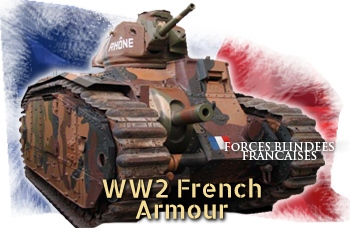 France came out of the First World War with the laurels of a winner and the promise of interesting developments with the little Renault FT, the first mass-produced modern tank. But the vagaries of the Fourth Republic and the choices facing an ageing staff would turn to the creation of a force largely marked by a strong defensive vision, relying mainly on the Maginot Line. French tanks were classified as their counterparts in Great Britain, in infantry and cavalry models, and some "chars de rupture" (breakthrough tanks). Production and testing was relentless in the twenties and thirties, leading to a new generation of armored vehicles in 1935-36, which formed the bulk of the armored forces of France (then numerically one of the largest in the world) in September 1939 (4436). By June 1940, 6126 tanks had been delivered to the army.
France came out of the First World War with the laurels of a winner and the promise of interesting developments with the little Renault FT, the first mass-produced modern tank. But the vagaries of the Fourth Republic and the choices facing an ageing staff would turn to the creation of a force largely marked by a strong defensive vision, relying mainly on the Maginot Line. French tanks were classified as their counterparts in Great Britain, in infantry and cavalry models, and some "chars de rupture" (breakthrough tanks). Production and testing was relentless in the twenties and thirties, leading to a new generation of armored vehicles in 1935-36, which formed the bulk of the armored forces of France (then numerically one of the largest in the world) in September 1939 (4436). By June 1940, 6126 tanks had been delivered to the army.
Characteristics and innovations
As far as tank design was concerned, the French engineers came with various innovative designs of their own. The army -partly because of political issues and spending concentrated on the Maginot line- was never given a sizable budget before 1932-34. This forced the use of the existing obsolescent types, the fleet of Renault FTs and the few, but impressive, FMC-2Cs. Renault attempted to modernize its best seller (very popular on the export market) and Panhard courted the cavalry with its armored cars.Both tried to implement the Kégresse track system, an innovative design which turned to be more useful on half-tracks. The mass-produced US M2/M3 models used such a system. The French adopted it for the AMC P16 and many off-road trucks and gun tractors delivered to the Army.
Articles
- ⚯ Main article
- Renault B1
- Renault D1
- Renault D2
- FMC-2C
- FMC-36
- Renault AMC-35
- Somua S35
- Renault AMR-33
- Renault AMR-35
- Renault AMC-35
- Renault NC27
- Renault UE
- Schneider P16
- Lorraine 37L
- Panhard 179
- Laffly W15 TCC
- Panhard AMD-178
- Panhard 165
- Laffly AMD-50
- Laffly AMD-80
- Dodge Tanaké
- French Softskin Vehicles
Other innovative features were more specific, like the oleo-pneumatic steering system designed to steer the massive hull of the B1 heavy tank. In this case, the driver was also aiming the main 75 mm (2.95 in) gun. Many other tanks allowed some limited traverse for their hull-mounted gun, compensating for the lack of precision of the standard brake-steering system. The French engineers, however, designed a system theoretically giving the greatest possible precision to the driver, allowing accurate traverse. However, this system proved too fragile and complex in operations.
French limitations in design
French tanks were generally better protected than their German opponents. The reasons behind was their doctrine of use. They were not seen as independent units, but spread among infantry units for close support on the battlefield. For this reasons strong armor was of capital importance, the speed was "infantry pace" and the low-velocity guns were meant to deal with concrete fortifications and pillboxes. These were all related to trench warfare and the experience of WWI. All these models, until 1937 at least, were designed for the same kind of operations practiced in 1918.Consequently the French tanks were generally slow (with the exception of cavalry tanks like the SOMUA S35 and scout tankettes) and relatively underpowered, although this was not seen as an issue, since infantry pace was required. Range was also limited by a greater consumption, but the tactical needs were limited in scope to the WWI typical battlefield, a 50-100 km (30-60 mi) area of operations. Radio communication between tanks was sorely lacking, with flags and couriers used instead. The common practice in 1935 was that only command tanks possessed a long-range radio.
On the German side, excellent training and communication between tanks and even between armored units and aviation reflected the emphasis put on the delegation of command to the lesser echelons and promoted personal initiative and flexibility. Tank conception reflected this. Mobility was preferred over protection and advanced intercom systems and communication between tanks were commonplace in 1938.
Demography was, surprisingly, a critical factor with French tanks design. After the Great War, the demographic pyramid was reversed in France and Germany, resulting in a natality gap largely favorable to Germany, which was crucial twenty years later. After 1935, the French were vividly aware of this, a fact that also reflected in the army's specifications. To cope with the normal provision of tanks per units, with limited manpower, the only option was to limit the crew to three and design the tank accordingly. The earliest model was the Renault FT, which was armed with a single weapon (gun or machine-gun). Its simplicity allowed a crew of two.
But when more complex requirements came, new tank models saw a multiplication of tasks which was not counter-balanced by an increase in crew numbers, nor a new turret design. The commander remained isolated in his single-man turret, with the task of commanding, loading and manning the main gun and the coaxial machine-gun, plus sometimes the radio. The driver and a loader/co-gunner/mechanic completed this busy crew. Consequently, the French tank commanders were overloaded and simply couldn't cope with other tanks maneuvering around or dealing with several threats at the same time. This helps explain why French tanks units were decimated, despite having better armor. Another issue was the lack of penetrating power of the French guns, the most common being the short APX (Puteaux) 37 mm (1.46 in) designed for infantry support.
General overview: French armored forces in 1939
In 1939, the French armored force was most important of the Allies, as the USSR was formally a German ally at the time. A total force of nearly 5,800 tanks, many of which were based overseas, in operational reserve or second line (such as the obsolete FT). The B1 bis became legendary for a short time, a terror for German tank crews. At Stonne, one of these tanks claimed to have destroyed as many as 13 Panzer IIIs and IVs. The Germans would not face such losses until they would encounter Soviet KV-1s and T-34s during Operation Barbarossa. The failure of French tanks was owed to obsolete tactical concepts, compromises which led to undermanned tanks and busy commanders, lack of air support and very poor communication aggravated by a rigid, scattered chain of command. In short, French armor could have had prevailed if better commanded and with better coordination and supplies. The ensuing losses were an incredible waste of military might, reproduced almost to the letter by the USSR in the summer of 1941. There, once more, the biggest armored force in the world was put in jeopardy by similar tactics to those applied in the French campaign, applied on a larger scale, with limited but well-employed forces.French tactical doctrine in operation
The prime doctrinal use was still related to a methodical set of rules based on the trench warfare of 1916-1918. This was favored by the old age of the French staff. The average French general was 70-80 years old, compared to their German counterparts, of average age 45-60. Only the young Colonel De Gaulle stood apart, writing memorandums, reports and a book about armored warfare. He knew well the works of Liddel Hart and Fuller. He saw the full potential of medium and heavy tanks screened by a force of lighter, but faster tanks, in independent, mobile armored divisions. All his ideas were ignored by senior officers, while, in Germany, Heinz Guderian carefully watched all of these theories.Trench warfare vision, without surprise, emphasized slow (infantry pace), but well armored vehicles, only armed for close support, mainly against pillboxes and trench fortifications. The old short-barrel Puteaux SA-18 37 mm (1.46 in) gun was by no means capable of anything else other than engaging fortifications and lightly armored targets at relatively short range. The models which mounted this gun were the Hotchkiss H35, Renault R35 and FCM 36, which partly replaced the old FT. Cavalry tanks like the SOMUA S35 and the AMR-33/35 tankettes inherited the standard cavalry doctrine, having to exploit any breakthroughs and piercing well into the rear enemy lines, disrupting communications, stopping reinforcements and destroying depots and other high value targets. For the most heavily defended lines (such as the Siegfried line), massive breakthrough tanks and SPGs were required. In 1935, these requirements were embodied by the B1 and the old FCM-2C. No true SPG, except very few modified FTs, were designed before 1939. Armored cars were intended to provide screening, scouting missions and patrol regular border roads.
The French campaign
The rest is history. The French fought hopelessly, completely disorganized by the speed of the German combined attacks. This was deepened by lack of training, weak and poorly coordinated air support, inadequate tanks, lack of modern equipment and, most of all, outdated tactics. As Guderian's armored group, the "falx" coming from the Ardennes, was a single, exceedingly stretched line, the French mounted several counter-attacks with all tanks available. Two of these, at Montcornet and Laon, were led by De Gaulle. All failed, notably because of relentless air attacks.Entire units were immobilized and many tanks abandoned due to the absence of fuel supplies. Most transport lines were slowed down by refugees or destroyed by air attacks. During the end of May, when the best French units had been already decimated in the North, what was left of the tank brigades was gathered locally to built the so-called "Weygand hedgehogs", used as mobile pillboxes. The Germans simply bypassed these with their mobile units, spearheading into the south, and all resistance pockets were left to the infantry, artillery and Stukas. The Maginot line fufilled its intended role, funelling German Forces elsewhere, where it can be dealt with, less the Ardennes coup. But it also retained sizable French forces to no effect.
Under Vichy and the occupation
After the armistice and until 1943, France was cut in two, on a line which roughly stretched from the very southern tip of the French Atlantic coast to Switzerland, making a bow on the river Loire, just south of Tours and Bourges. This half was placed under the authority of a legitimate (at least recognized by most countries) French Government settled at Vichy. Its position as a neutral, but "collaborating" nation, was radicalized in time in terms of collaboration with the occupying German Forces, and the resistance movement grew accordingly.The fact is that the French empire still possessed territories and powerful military assets in its hands, especially the Fleet, that interested or threatened the Allies in their reconquest plans. The French colonies in North Africa still possessed armored vehicles, mostly obsolescent models, like Renault FTs, a few Renault D1s, some Hotchkiss H35/39s and Renault R35s, alongside many armored cars. These vehicles were committed in various engagements against Allied troops, like against the Australians in Syria-Lebanon and the US and British troops during operation Torch. In French Indo-China, in 1941, the few FTs still operational were used against a Thai invasion supported by Japan. A few AVFs saw action with the Free French under Gen. Leclerc (Koufra raid).
The Free French forces
Starting in November 1943, as an answer to the Allied landings in North Africa, the Germans took hold of unoccupied France. What was left of the Mediterranean fleet was scuttled. Admiral Darlan, the Vichy authority in North Africa, decided to side with the Allies.When the French 1st Army (under general De Lattre) landed in Italy, its force comprised mostly infantry -the rugged Goumiers and other African colonial troops which counted 50% of the original 130,000 men, with artillery support, jeeps, trucks, M5 half-tracks, M3 scout cars, a few M3 Stuarts and some M4 Shermans.
When the Free French 1st Army landed in Southern France in August 1944 (Operation Anvil Dragoon), it had three fully fledged armored divisions (1st, 2nd and 5th). They were equipped with M3s and M4 Shermans, receiving some M10 Wolverines in the fall of 1944. It took part in the fighting at Vosges, Colmar, the Rhine, Strasbourg, captured Karlsruhe and Stuttgart and cleaned most parts of southwestern Germany and the Black Forest. After the war, these US-built vehicles were used during the Indochina war (1945-54) and Algerian war of independence (1954-62).
Armored cars
Like many other nations of the time, France relied on armored cars to patrol one of the best road systems in western Europe, due to their availability and ease of production.- Berliet VUDB
50 built for service in the North African colonies.- Citroën-Kégresse P28
Only 50 such half-tracks were built in 1928, plagued by various faults.- Laffly S15-TOE
Six-wheeled vehicle designed as a troop transport, armed with a 37 mm (1.46 in) gun and a Reibel machine-gun.- Panhard AMD 165 & 175
60 built in 1935, with 9 mm of armor, armed with a 37 mm (1.46 in) gun and a Châtellerault 7.7 mm (0.3 in) machine gun.- Panhard AMD 178
All-terrain vehicle equipped with a QF high-velocity 25 mm (0.98 in) gun and a coaxial machine gun. The AMD 40 was an improved model sporting a new turret and a more powerful 47 mm (1.85 in) anti-tank gun.- Schneider AMC P 16
100 such half-tracked vehicles were built between 1928-31.- White-Laffly AMD-50
96 converted and modernized vehicles in 1932, based on the body of the old White armored car.- White-Laffly AMD-80
Based on the old Laffly 1918 chassis. Already obsolete in 1934 when it entered service. Served only in Tunisia.Light tanks
Since the introduction of the Renault FT in 1918, France favored large fleets of light tanks for infantry support. Medium tanks were mostly regarded as cavalry models, able to deal with other tanks, while the heavy ones were meant to make breakthroughs and deal with any opponent in the process. The bulk of the French armored forces was, by far, composed by the immense fleet of now obsolete Renault FT tanks. Many were sold, some modernized and others sent to the colonies. Those still extant were now in reserve or used as training machine. Between 1923-26, Renault made several attempts to modernize the FT fleet with the NC lineage and Kégresse derivatives, using the brevetted soft track system invented by Adolphe Kégresse. Nonetheless, production was insignificant. The Vickers-Carden-Loyd tankette had some influence over French designs. The AMR 33, AMR 35 and AMC 34 were basically scout tankettes, comparable to the British Light tank models and the German Panzer I. Also inspired by the British design was the unarmed Renault UE supply tractor, the most produced tankette in the world aside the British Universal Carrier. Renault later came with new models, the D1 and then the D2, built in 1931-35. But both remained unsuccessful. In 1935 Renault produced the R35, an answer to Hotchkiss and its H35. Both were designed for the same specifications, calling for a mass-produced light tank purely for infantry support. Both were simple, affordable, well-protected, but also slow and with the same 37 mm (1.46 in) short barrelled gun designed to deal mostly with concrete pillboxes. They were upgraded, some receiving radio sets and a longer barrel to deal with other tanks, but these came too late. One of the best designs was Renault's AMC 35, the first French tank with a three-man turret, but too few were built in time. It was equipped with a gun meant to deal with other tanks, the 47 mm (1.85 in) model 1933. Puteaux manufactured most of these guns and cast the turrets.- FCM 36
Light infantry tank with a strong sloped armor, mounting a short-barreled 37 mm (1.46 in) gun and a MAC 31 machine gun. 100 produced between 1938-39. Two other orders were canceled, the provider increasing the price of its machines from 450,000 to 900,000 francs.- Hotchkiss H35
Mass produced infantry light tank. Slow, armed with a short barrel and a machine gun support, but very well protected. Formed the backbone of the French armored forces in 1940. H39: A modernized version of the H35 developed later (1939-40), significantly faster and better armed.- Renault AMC 34
Fast tank armed with an anti-tank QF 25 mm (0.98 in) gun coupled with one or two 7.5 mm (0.295 in) machine guns.- Renault AMC 35
The last Renault design, a light tank armed with a 47 mm (1.85 in) gun and a coaxial Reibel/Hotchkiss machine gun. Two man turret.- Renault AMR 33
These fast tankettes were similar to the British Vickers Light Mk.III. They were used as armored reconnaissance vehicles.- Renault AMR 35
Improved version of the AMR 33. Armed with a single 7.5 mm (0.295 in) Reibel or a heavy 13.2 mm (0.52 in) Hotchkiss machine gun.- Renault D1
These light infantry tanks succeeded the FT. Their armament consisted of a long-barreled 37 mm (1.46 in) SA34 gun and a MAC 31 7.5 mm (0.295 in) machine gun. 160 vehicles built between 1929-1930.- Renault D2
Improved light infantry tank, with a SA35 47 mm (1.85 in) gun and two MAC 31 machine guns.- Renault FT 31
In 1939, 600 of these small FTs were still in the French defense forces, barely modernized. Two versions were available, the FT "canon" with a 37 mm (1.46 in) Puteaux SA18 and another version with a 7.9 mm (0.31 in) Hotchkiss machine gun.- Renault NC1/2
No such vehicle was in French service. About 40 were exported and around 11 prototypes existed including the NC31, direct ancestor of the D1 tank.- Renault R35/40
A mass-produced light tank for infantry support with the short gun Puteaux 37 mm (1,46 in) gun and a coaxial MAC-31 machine gun. 765 such vehicles were fielded by the French in 1939 . R40: Improved version of the R35 with a long SA38 37 mm (1.46 in) gun with good anti-tank capacity and 60 mm (2.36 in) of armor.Medium tanks
For a long time, the vision of General Estienne prevailed in regards to tank design and deployment. Emphasis was on overwhelming the enemy with a swarm of light tanks, which were a cost-effective solution, being less expensive and with smaller crew. The French army still needed better tanks to exploit gaps in enemy lines and make deep penetrations, and this role was traditionally taken by cavalry units. These were supplied, until then, with armored cars and scout tankettes (also classed as "armored cars"), the only vehicles allowed by law. The political mood changed when faced with German rearmament and moves in central Europe, towards Austria and later Czechoslovakia. The law was amended to allow the cavalry to acquire real tanks, and its first choice was to purchase the SOMUA S35, one of the best tanks in Europe in 1935.AMX 40
A medium cavalry tank that remained only a paper project, designed by AMX (formerly SOMUA). It was characterized by a well-rounded hull and turret, had more ammunition, torsion-arm system suspension with four 82 cm (32 in) roadwheels, was faster and possessed a radio compared to previous vehicles. It was a 20-ton tank propelled by a 160 HP engine. It was scheduled for production in mid-1941.- SOMUA S35
Medium cavalry tank with a cast hull, fast, well-armed and well-protected, but costly. Few were produced, with about 430 delivered by May 1940.- SOMUA S40
A close evolution of the S35. It replaced it in production in May 1940. It was faster, mounting a new diesel with 220 hp, and had larger track links. Unfortunately, very few were delivered on time to serve during the campaign.Heavy tanks
- ARL 1937
Successor of the B1, three prototypes produced. Heavier armor, 47 mm (1.85 in) howitzer for anti-tank purposes, 2 or 3 MAC machine guns (one in an anti-aircraft mount) and a flame thrower.- B tractor AMW/AMX 39
A successor for the B1 studied and tested too late for mass production. Improved version in all respects with 80 mm (3.15 in) of frontal armor, 4 men crew, a 75 mm (2.95 in) hull-placed howitzer, completed by a high velocity SA39 47 mm (1.85 in) gun in a turret to counter other tanks.- Char B1/B-1 bis
B1: Prototype ready in 1930, production limited to 35 units. 47 mm (1.85 in) gun in the turret and a 75 mm (2.95 in) howitzer mounted in the hull. B1 bis: Improved version with a new APX-4 turret with a SA-35 high velocity AT gun and 60 mm (2.36 in) frontal armor. 369 units built by June 1940, approximately 340 operational in May. The most impressive asset of the whole French arsenal. The B1 ter was never put in service. It was protected by sloped armor and had a more powerful engine.- FCM 2C
Super-heavy tank planned in 1916, designed in 1917 and built in 1921 after many changes. Ten produced and retained for propaganda reasons. 70 tons, propelled by two diesel V6 Maybach engines, with 45 mm (1.77 in) of frontal and turret armor, a 75 mm (2.95 in) APX 1897 gun, four Hotchkiss machine-guns, with a crew of 12.Links about French WW2 AFVs
French Tanks original blueprints Chars-Francais.net, one of the best website about French tanks and armored cars (in French) About French Tanks (Wikipedia) French tank production WW2 (from Wikipedia) GBM, Histoire & Collection, about WW2 French tanks Minitracks.fr, comprehensive monographies about WW2 French AFVs. The Shadock, a comprehensive gallery of surviving WW2 French tanks French interwar tanks on Alernativefinland.com Rare french projects of WW1 and the interwar (Wot-News)
Lorraine 37L of the 342th independent company operating in Norway, March-April 1940.

Lorraine 37L of the 3/15e BCC in May 1940.
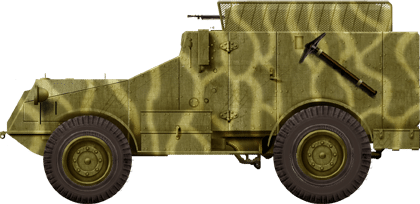
Panhard 179 Armored Car

The Renault FT-31 (or "modifié 1931"), a limited upgrade of the WWI-vintage famous Renault FT, which was applied to all the 1580 FT machine-gun versions still in depots at the time. The gun versions were scrapped and their Puteaux guns reused on new models. They were rearmed with the compact MAC Reibel 7.5 mm (0.29 in), a gas-operated machine gun, firing 750 rpm at 830 m/s (2723 ft/s) muzzle velocity, originally created for the Maginot line in 1931. It was the main French tank machine-gun by 1940, also operated by the AMR 33/35, Hotchkiss H35/39 and Renault R35/40.
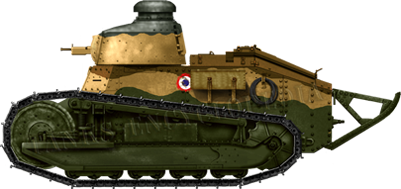
FT-31 of the 31 BCC ("Bataillon de Chars de Combat"), May 1940.
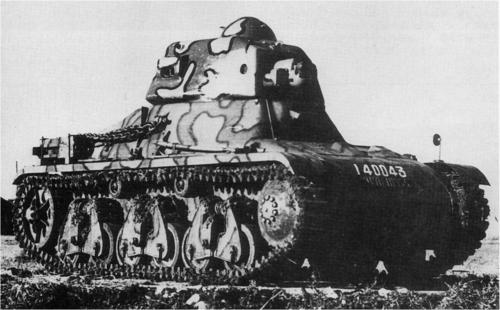
The Hotchkiss H35, the only tank produced by the famous gun manufacturer (of American origin). The H35 was innovative with hull assembly in three prefabricated cast sections. It was a slow, weakly armed, but well armored infantry tank for the time.
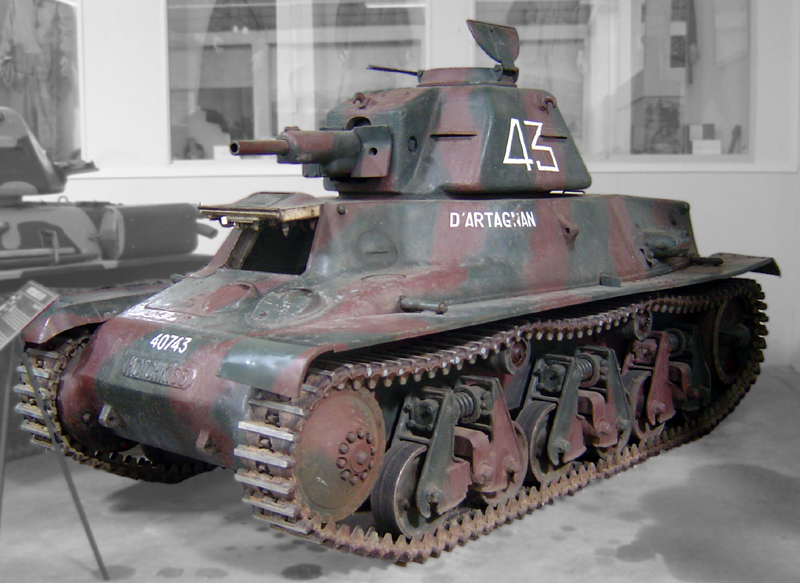
Hotchkiss H39 at Saumur. Saumur musée des blindés (tank museum) has the world largest collection of French WW2 and WW1 tanks in the world, along with 600 tanks of other nations, mostly of WW2 era.
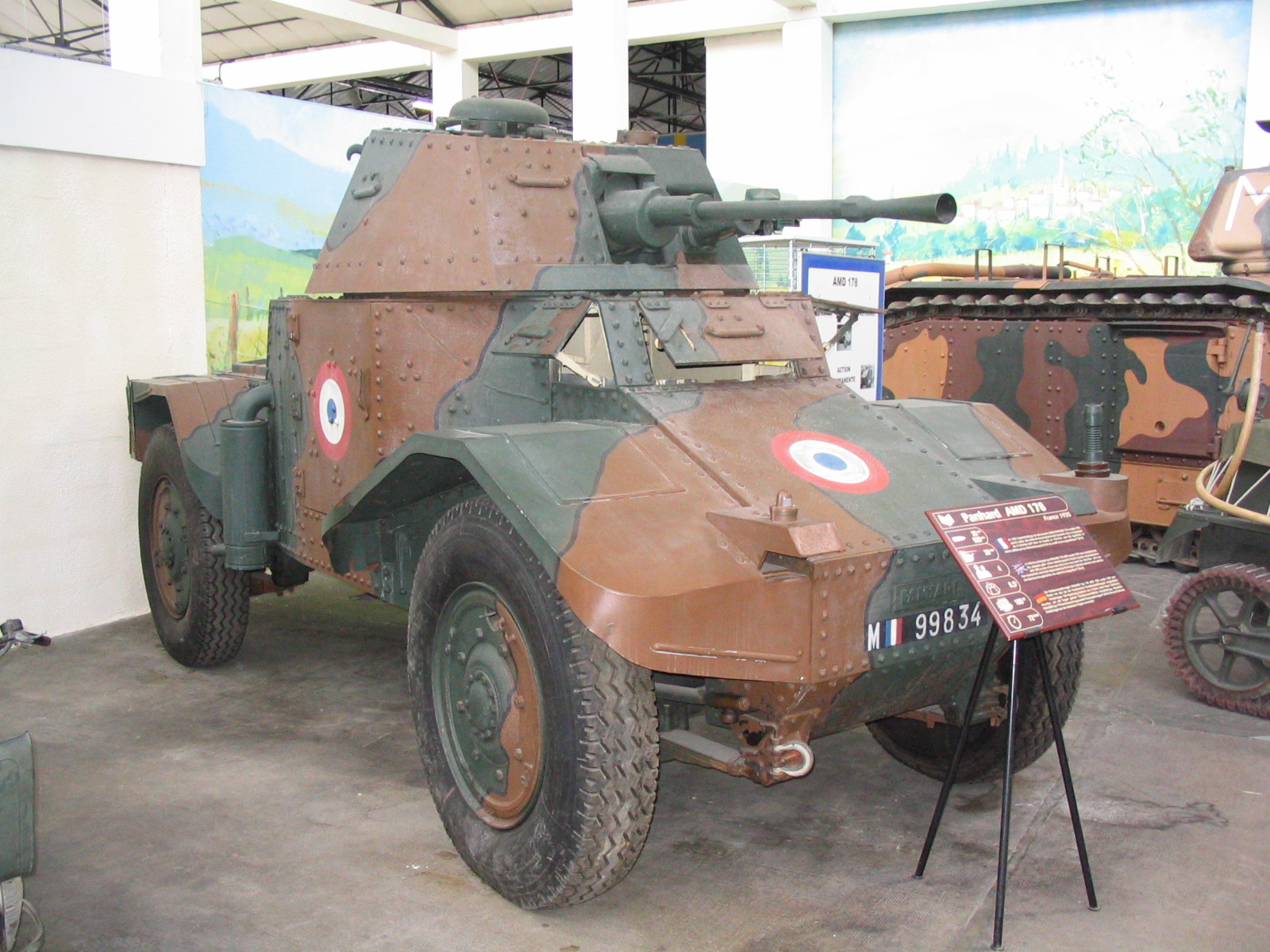
Panhard AMD 178, one of the most successful French armored scout cars.
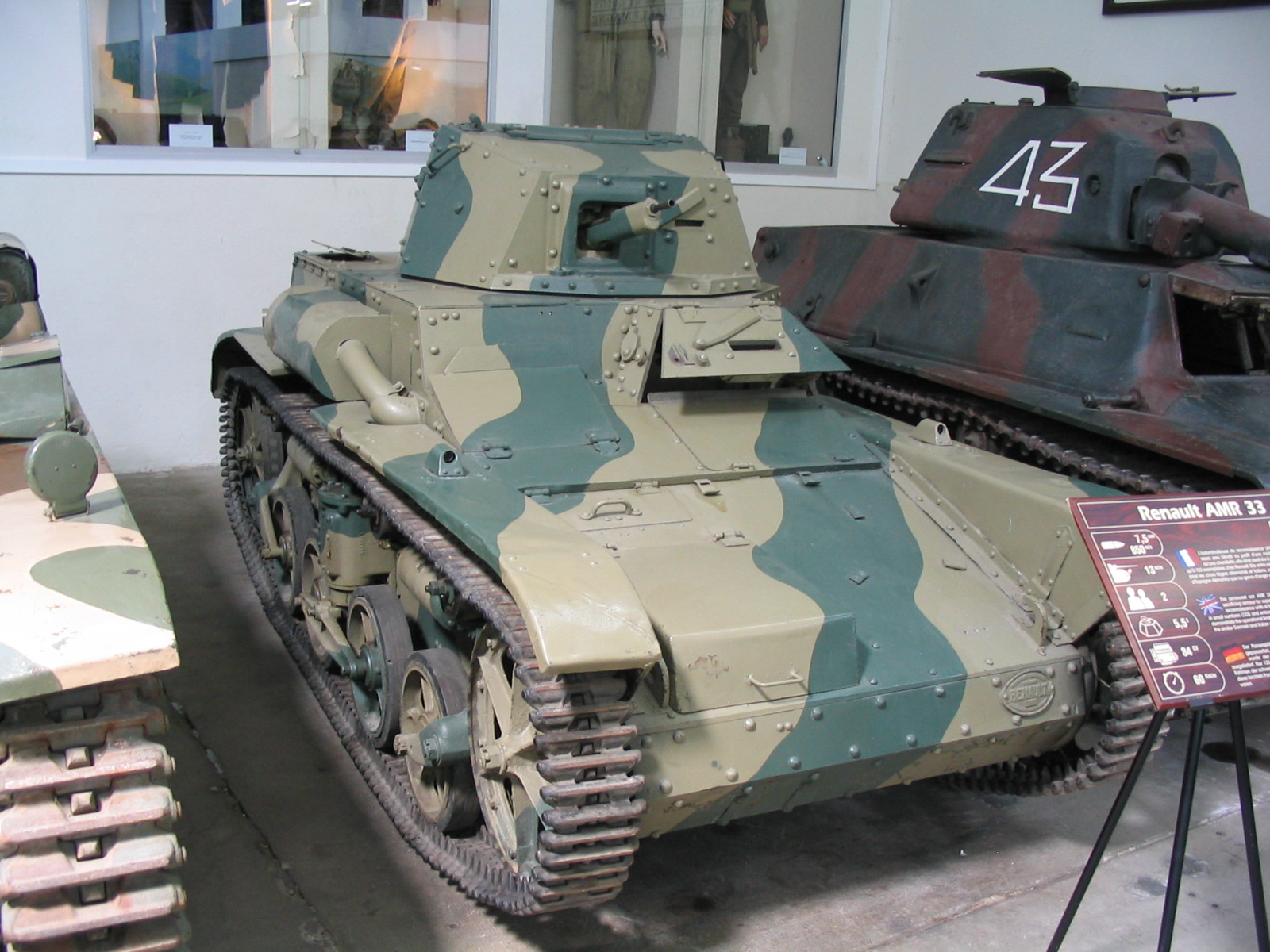
AMR 33, a fast cavalry French reconnaissance tankette, influenced by the British Carden-Loyd designs.
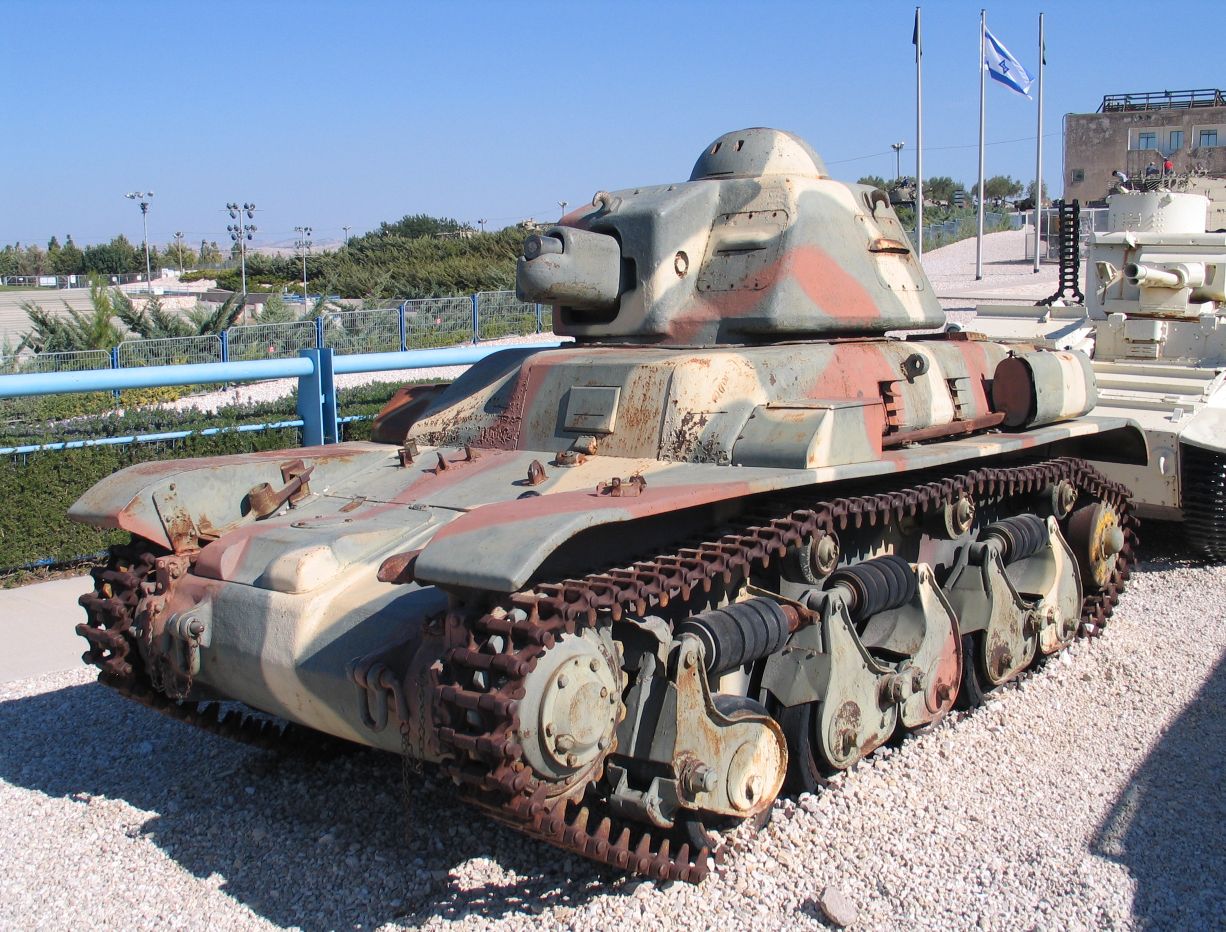
Renault R35, one of the most prolific infantry tanks of the thirties.
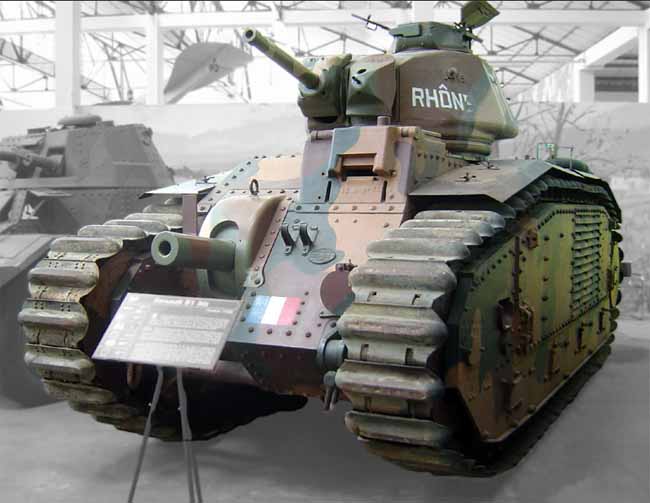
The Char B1 bis forged a legend of its own during the desperate counter-offensives of May 1940, notably at Stonne. Nearly impregnable, well-armed, it was the nightmare of all German crews during the battle of France. Fortunately for them, poor coordination, no air support, lack of orders, ammunition and fuel prevented full effective use. They saw a second career on the Eastern Front, against the well-armored Russian tanks.
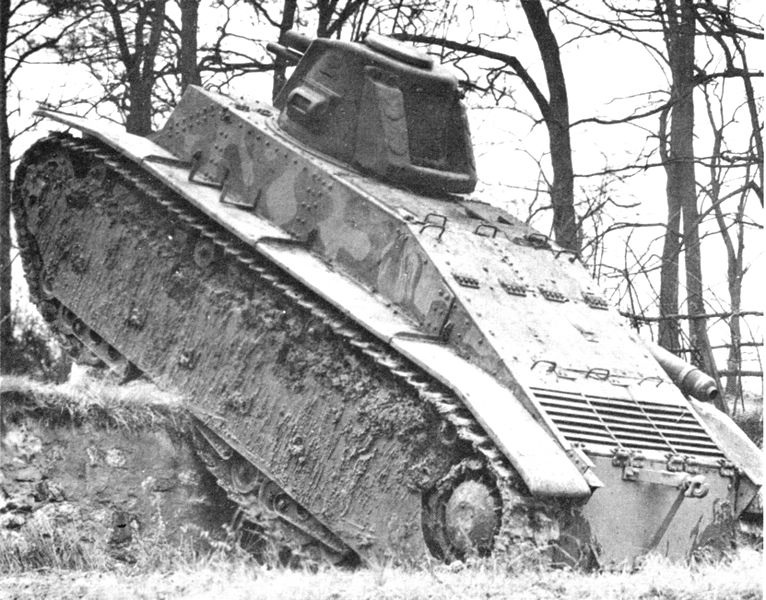
Char D2, a follower of the earlier Renault D1 infantry tank. Very well protected, with essentially low velocity guns meant to deal with lighter tanks and all kind of casemates and blockhouses on the battlefield in a relatively static war.
Prototypes
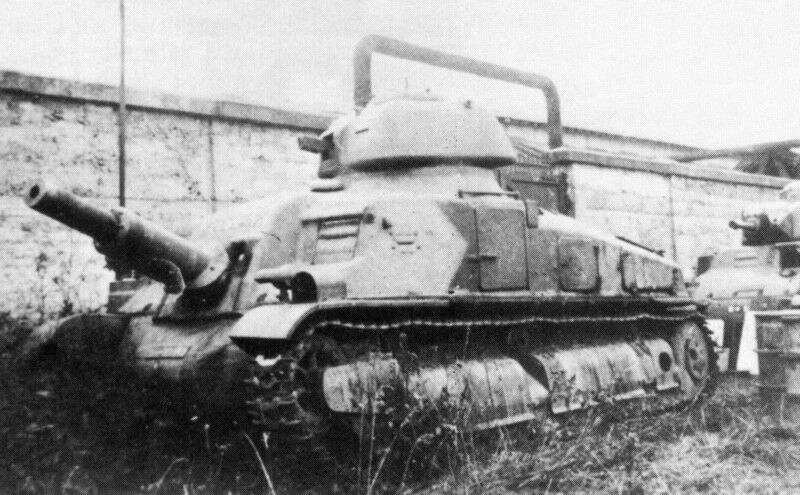
Char SAu 40, an attempted SPG based on the SOMUA S35 chassis. It was armed with a 75 mm (2.95 in) howitzer, but the 47 mm (1.85 in) gun in the turret was replaced by a Reibel machine-gun.

Char ARL 40, a prototype SPG tank-hunter, armed with a 75 mm (2.95 in) APX gun. It was capable of 42 km/h (26 mph) and scheduled for production in June 1940.
The Free French
Not all officers stayed faithful to the new government headed by Petain when the latter decided to surrender. One of these was Charles de Gaulle. The object of this part is not to make a complete biography, related his political career or (rocky) relations with the allies, but describing the chief of the Free French and the mechanized forces nehind and their actions. Before the war de Gaulle was known as a tank theorician, he was the only officer to see the uselfuless of combined-arms tactics centered around large tank units, and a smaller but much more professional (and fully mechanized) army in "vers l'armée de métier" ('Toward a Professional Army') in 1934. He stressed on an élite force of 100,000 men and 3,000 tanks, better integration with aviation and total autonomy from the infantry.His views on tank concentrations and autonomy slowly percolated in the high command (not without resistance), enough to led to the constitution in 1940 of the DLM (Division Légere Mécanisée), which was closing to, but still not equivalent, to a Panzerdivision. DLM stands for "Divisions Légères Mécaniques" or Mechanised Light Divisions. Equipped with heavier tanks was established the DCR or Division Cruirassée (Armoured division). Basically the DLM was the armored reconnaissance equivalent to a DCR. To this were added a few CFM or "Corps-francs Motorisés", or motorized "Freikorps" enjoying greater autonomy and flexibility.
De Gaulle wrote also in 1938 "La France et son Armée" (France and Her Army) but at that stage, he had attracted sympathy from the new left-wing Popular Front government, especially President Paul Reynaud and befriended with the minister of war Édouard Daladier, but defnitively alienated Pétain and most of the general staff. Despite his books has been read in France but also Germany, he was never promoted Colonel at that stage as his intensive lobbying as a lecturer and political support were disapproved.
De Gaulle's armored successes
In September 1939 De Gaulle was in command of the five Fifth Army's battalions equipped with R35 and advanced well during the Saar offensive, only to be ordered back by Gamelin like the rest of the army. In May he was given command of the 4th Armoured Division (DCR), activated on 12 May, two days after the Germans launched their Ardennes offensive. The situation deteriorated fast, and he was ordered to gain time of General Robert Touchon's Sixth Army to redeploy from the maginot line, with free hands to apply his ideas. He attacked in force at Montcornet, a key road junction near Laon but the German flank was well protected and lost 23 of his 90 vehicles to mines, anti-tank weapons and Stukas.He attacked again on 19 May, reinforced with a total of 150 tanks, only to be rebuffed again by German Stukas and artillery. He however achieved one of the rare successes of the campaign, forcing the German infantry to retreat to Caumont, with heavy losses. He asked two more divisions from Touchon to reiterate his attack, which were denied. However his efforts were recoignised and he was promoted as Brigadier-General, a grade he will keep until the rest of his life. His last action occured on 28–29 May, when he attacked the German bridgehead south of the Somme at Abbeville, taking around 400 German prisoners, in order to create a corridor for allied escaping forces to Dunkirk. But this was a futile effort at that point.
France's fall
On 5 June, De Gaulle became a government minister, Under-Secretary of State for National Defence and War, by PM Paul Reynaud. He was in particular in charge of coordination with the British, helped by Geoffroy Chodron de Courcel as translator and aide de camp. His views of continuing the fight notably from the colonies were met with frank scepticism notably by Weygand and the general staff. On 9 June he met for the first PM Winston Churchill and confered on an effort to move one million men to North Africa and tried to covince him to implicate more the RAF in the fight. He was also advocating the creation of a "redoubt" in Brittany.He also latter asked De Lattre to defend Paris to the last man, whereas it was soon declared an open city instead. On 13 June at Tours an Anglo-French conference seems to lean towards France seeking an armistice, but with the Fleet in balance. After making plans again for a potential evacuation to North Africa and a meeting with Darlan (CiC of the French Navy), on 16 June he was in london, 10 Downing street, talking with Jean Monnet's proposition for an Anglo-French political union which would have prevented any capitulation. This was freshly greeted in France by Reynaud, learning later the cabinet rejected the proposition. Soon Pétain became the new PM and requested an Armistice.
Exile in london
The path to build a Free French Army was long and rocky at best. After (reluctantly) fleeing to London, which was seen later as a treason by Vichy, the first (symbolic) act was a declaration at the BBC on 18 june to continue the fight. It was just one day after Churchill's "Finest Hour" speech and after Pétain's broadcast to cease fighting. It was seldom heard in France, whereas a very few of those evacuees from Dunkirk and Norway choose to stay. Instead the immense majority decided to return in France to become PoW.De Gaulle met also little success from the French Empire. After faling to establish contact with North Africa, Churchill and the British Government recognised de Gaulle as leader of the Free French on 28 June, whereas the legitimacy of the Vichy Govt. and armistice was denounced whereas Pétain's Govt. was recoignsed by both the US and USSR. At that time, De Gaulle's 'Free French' consisted in three colonels, a dozen captains, and three battalions of legionnaires, and later Admiral Muselier. As joining london was seen and condemned as a desertion by Vichy, only a dozen pilots made it to England and later 3,600 sailors operating 50 ships.
The small Islands of New Hebrides were the only territory of the Empire also to join him. De Gaulle little successes were even jeopardized completely after hearing the news of the attack on Mers El Kebir on 3 July, as he put it "this was in our hopes, a formidable axe blow". However later he would declare "Our two ancient nations... remain bound to one another. They will either go down both together or both together they will win".
Constitution of the Free French Forces
The next step, building the Free French Force would take three years. He made 4 Carlton Gardens in central London his provisional HQ and by 7 August 1940, Britain agreed to fund the Free French, with the bill settled after the war. His first success in the empire was the rally of General Georges Catroux, Governor of French Indo-China. On September 1941 de Gaulle formed the Free French National Council, attracting by then a lot of resistants, crossing the channel, from a broad political spectrum. After July 1942, the Free French were separated into the "exterior forces" or FFF and the "interior resistance" called the FFI, coordination was led by French and British special operatives. In April 1941 his little force received the support of 550 volunteers from French Pacific Islands, notably Tahiti. They would be grizzly veterans in 1945, having fought through the North African campaign, Italy, Provence and Alsace. They were also joined by 5,000 non-French Europeans, mainly from the Foreign Legion. His young army first action was at the ill-fated Anglo French attack of Dakar (Operation Menace) in September, but he failed to rally the colony, but met more success in Gabon in November. That was the start of General Philippe Leclerc de Hauteclocque ("Leclerc") successes.Leclerc's North African campaign
Free French 271th CCC's R35s in Gabon
Leclerc, a veteran from Norway and already a succesful commander joined De Gaull early on and adopted his pseudonym to avoid risking retaliation to his family back home. He was ordered by De Gaulle to launch an operation against Vichy-held Gabon and rally it by force, hoping other parts of the Empire would join later. It was prepared from August 1940 in French Equatorial Africa, where local leaders were already acquired to Free France, like the the governor of French Cameroon. Leclerc had under him the 13e DBLE and Senegalese Tirailleurs. The Battle of Gabon lasted from 12 October to 12 November 1940. Helped with the Royal Navy, the strategic location of Port-Gentil on the coast was secured. It ended with the fall of Libreville under the hands of Leclerc's subordonate, Marie Pierre Koenig, despite a strong resistance from Vichy troops. Vichy prisoners were held as hostages in case Vichy France tried to retaliate against the families of Free Frenchmen.
Next, Leclerc targeted the Sahara Desert border with Italian-controlled Libya and its two outposts, Murzuk and Kufra. There were 1,000 miles (1,600 km) to cross from the base at Fort Lamy, Chad. Murzuk was raided by eleven men of the Régiment de Tirailleurs Sénégalais du Tchad and two of the British Long Range Desert Group (LRDG) in January 1941, but in February, he led a large operation against Kufra, which housed a full Italian garrion. In the past, this has been an important trade and travel centre for the Berbers and Senussi. Since 1931 it was incorporated in the defense system of Libya and comprised a garrison with artillery and vehicles, the Buma airfield and a radio station. D'Ornano which directed the succesful attack on Murzuk died in action, so his motly force was led by Koenig on Kufra. It had at its disposal 5,000 Senegalese tirailleurs from Chad, from twenty companies and three detachments of méhariste (camel cavalry).

His force comprised 400 men in sixty trucks, two Laffly S15 TOE scout cars, four Laffly S15R and two 75 mm (2.95 in) mountain guns. The Italians could count on a network of barb wire, trenches and machin gun posts around El Tag fort, plus light AA guns. The Regio Esercito garrison comprised the 59th and 60th MG companies, 280 askari and the motorized Compagnia Sahariana di Cufra with SPA AS37 vehicles, 120-men strong. Kufra was an oasis which represented the whole area, with the fort and village. Koenig directed the LRDG to take care of the Saharan company, and they purposedly launched a radio message, intercepted by the Italians which depatched one AS37 and four FIAT 634 lorries to intercept the convoy, 30 men in 11 trucks. Both forces spotted each others on 31 January, off Bishara (130 km (81 mi) south-south-west of Kufra. The engagement was a disaster and Major Clayton was made prisoner. Plans of Koenig's attack on Kufra were also captured. This did not prevented Koenig to resume his advance, and reorganized his forces on 16 February, abandoned his two armoured cars, only keeping one field gun. They later fell on a second Italian column of seventy men, ten AS37 and five trucks, and won, not without loosing many trucks to the Italian AS.37 autocannons.
Only 350 men reached Kufra, the remainder on foot due to trucks breakdowns, well behind. On placen, Koenig moved its gun on a circle 3,000 m (3 km; 2 mi) around the fort reinforced by mortars to give the impression of several artillery pieces, and after a few days of pressure, this was enough for the inexperienced reserve captain who surrendered on 1 March 1941. Casualties has been relatively light on both sides, and the French took possession of eight SPA AS.37 Autocarro Sahariano light trucks, six lorries, four 20 mm cannon and 53 machine-guns. After the battle, he had his men swear an oath known today as the Serment de Koufra ("Oath of Kufra") to not stop until the flag floated on Strasbourg's Cathedral. The unit was renamed later Free French Orient Brigade, took part to East African Campaign, the capture of Karthum, the Battle of Keren, the Syria-Lebanon campaign, and as the 1st Light Free French Division fought Vichy French troops through Homs, Aleppo, Beirut and arrived at Cairo to be dissolved. Next stop was the Battle of Bir Hakeim.
The turning point of Bir Hakeim

Another FF officer soon earned for the Free French international recoignition in the battle of Bir Hakeim, a staunch defense of an old Turkish desert fort, osasis and strongpoint which lasted from 26 May-11 June 1942, against at first by Ariete Division in the first phase of the Gazala battle, and in a second phase against elements of the Trieste division and German 90th Light Infantry Division. The defence was assumed by the 1st Free French Division of brigadier general Pierre Kœnig. On the strategic level it was on the hinge of the British defense peritimer, in the deep south. When the British forces retreated, Bir Hakeim allowed to deny the axis a turning move which had conducted them to probably quickly surround the allies. The resistance led Rommel do direct personally the operations.
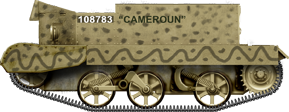
Free French Universal Carrier
Koenig had at is disposal a fighting strength of 3,000 men, a rear echelon of about 600 men, mortars, a few artillery pieces and AT rifles, no tanks but sixty-three Bren Gun Carriers divided into three squadrons. The first attack waves comprised M13/40s tanks of the 8th Reggimento bersaglieri and 132nd Artillery Regiment, but they failed to cross minefields and were greeted with an intense fire of AT guns, mortars, and field artillery (75 mm) in straight trajectories. The Ariete Division was reduced to only 33 tanks in 45 minutes, and the remainder was lost in another attack which conducted Rommel, more successful in the north to completely surround the French and ordering a new attack by the Trieste Division supported by the 15th Panzerdivision, with constant artillery pounding and Stuka attacks.
He was ultimately successful, forcing the defenders to withdrawn by night through minefields and axis positions to allied lines. This was a strategic defeat, but Bir hakeim was a pyrrhic victory for the axis, and allowed the allies to safely regroup and prepare the defence of El Alamein. The Free French feat earned universal applaud and the admiration of Rommel himself. Later as the 1st Motorized Infantry Division, Koenig's unit took part in the Tunisian campaign and was integrated with the armée d'Afrique and became in Italy the 1st Marching Infantry Division.
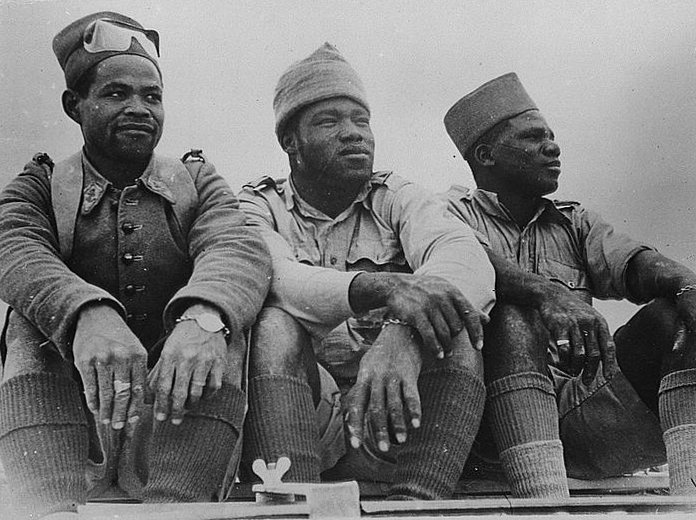
Free French soldiers of the colonial artillery. The force under Koenig was a highly mixed one, with foreign legionnaires, marine troops from the Pacific, Alpine troops, Palestine Jews, Republican Spanish, and from all corners of the Empire.
About the 2nd DB (2nd armored division)
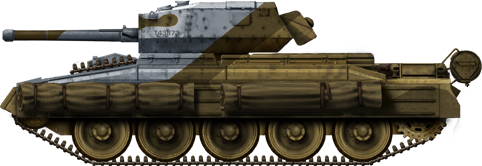
Free French Crusader Mark III in Tunisia
Illustrations
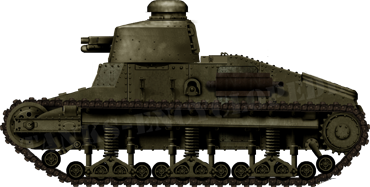
The Renault NC1 prototype in 1926.
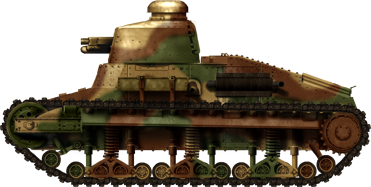
Renault NC1 in Polish service, in 1939. Contrary to some publications stating that 24 of these NC1/NC27 were purchased, only one was bought. This is a prospective view of a NC27 in standard Polish camouflage in September 1939, as there are no photo records of this model. The Polish army counted also 5 Kegresse-type NC2s. In Polish nomenclature, they were classified as "Renault FTs". Fate unknown.
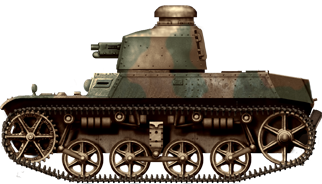
AMC 34, early model with the 1917 cast Berliet turret.
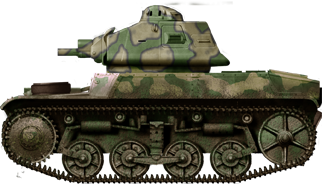
AMC 34 with the definitive APX-1 turret, Chasseurs d'Afrique, Morocco, 1940.
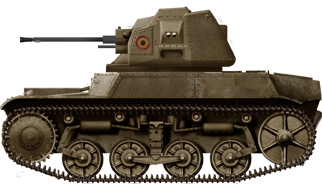
What-if Belgian AMC 34 with the APX-2 turret and 25 mm (1 in) gun, later replaced by Belgian 47 mm (1.85 in) guns.
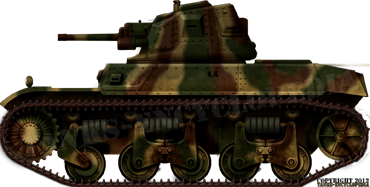
Renault AMC 35, 11e Groupement de Cavalerie, Loire region, June 1940.
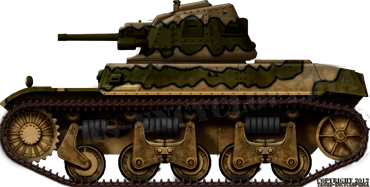
An AMC 35 from the hastily equipped CFM (Corps Francs Motorisés) which fought a delaying action between the rivers Seine and Loire in June 1940. In all, five CFMs of seven tanks each were formed, but only two were ready in time to operate effectively.
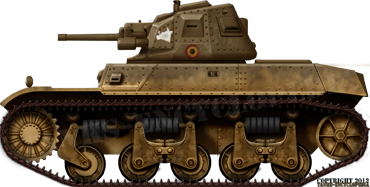
Belgian Char Moyen de Combat Renault ACG1 Mod. 1935, one of the 10 delivered until January 1940 (of the 25 originally ordered). It fought at Antwerpen (Antwerp).
.png)
PzKpfw AMC 738 (b) of a training unit. It was deemed so unreliable that it is unclear if any of these were really put in action against the "maquisards" and partisans, although a unit of AMC 738(f) has existed in Wehrmacht service.
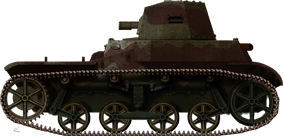
Prototype, with the early type turret, Champagne maneuvers, autumn 1933.
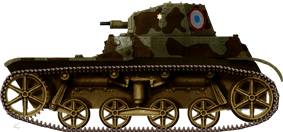
AMR 33 from the 4th BCL, January 1939.
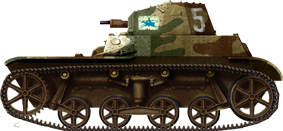
AMR 33 from the 3rd DLC, Ardennes sector, 11-12 May 1940.
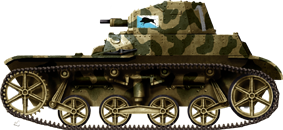
AMR 33 from the 7th DLM, June 1940.
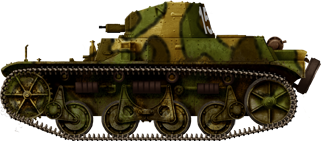
Regular AMR 35, equipped with the AVIS-1 turret (Batignolles-Châtillon) and the 7.5 mm (0.295 in) Reibel Châtellerault MAC31 machine gun. 87 built in all.
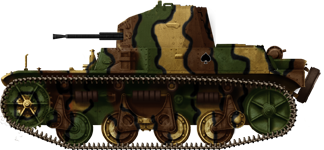
AMR 35 ZT-1 equipped with a heavy 13 mm (0.51 in) Hotchkiss machine gun with 1250 rounds. Fitted with the AVIS-2 turret, 80 built.
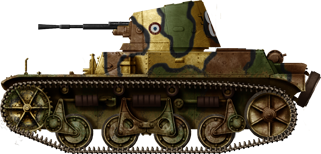
AMR 35 ZT-2 tank hunter. APX 5 turret (built at Atelier de Rueil) and 25 mm (0.98 in) SA35 L47.2 or L52 autocannon (78 armour piercing and HE rounds) with a secondary 7.5 mm (0.295 in) Reibel coaxial machine-gun. Only ten built, after production dragged on until 1940. They completed the intended RDPs batallion organic strength.
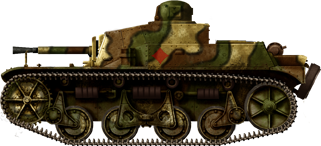
AMR 35 ZT-3 SPG tank hunter, with a 25 mm (0.98 in) SA34 L72. Ten were built at APX (Ateliers de Puteaux) until September 2, 1939.
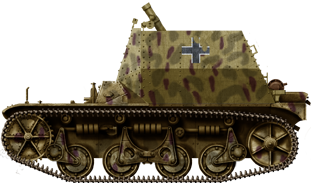
A rare German battlefield conversion, 8cm Schwere Granatwerfer 34 auf Panzerspähwagen AMR(f) self-propelled heavy mortar.
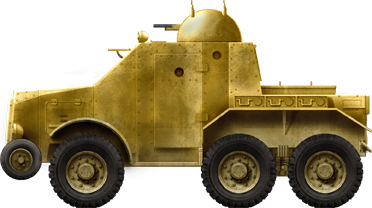
Laffly S15 TOE in Syria, 1941.
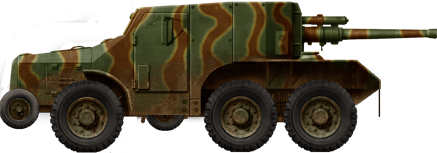
The Laffly W15 TCC fully enclosed prototype on trials at Camp of Mailly in April 1940 and with the 1st DCR. Despite being successful, Generalissimo Pierre Gamelin refused the conversion, because of insufficient protection and other priorities. But, after the 17th of May, an order came for the delivery of 5 vehicles per day. Laffly never came near this figure, but delivered 60 vehicles, only partially protected due to the lack of time.

Series Laffly W15 TCC, May 1940. Some were also camouflaged with brown stripes.
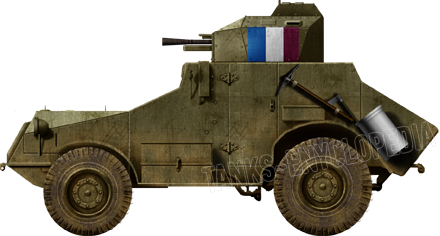
The basic Panhard 165 of 1933, here with a wartime modification, the replacement of the 37 mm (1.46 in) Puteaux by a 25 mm (0.98 in) antitank gun.

A camouflaged Panhard 175 TOE of the 3rd BCA (Bataillon de Chasseurs d'Afrique) - Click for the HD version.

The closely derived Panhard 179, also with the 3rd BCA (Bataillon de Chasseurs d'Afrique)
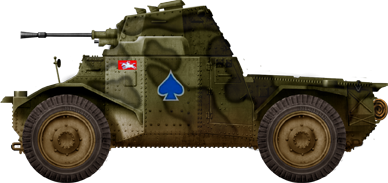
Panhard 178, early production, 6th GRDI, 2nd Squadron, France, May 1940.
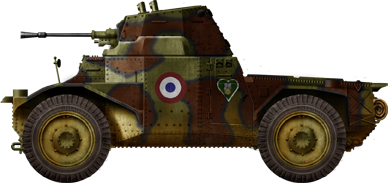
AMD 35, late production (4th prod. batch), 8th Cuirassiers, 2nd DLM, France, September 1939.
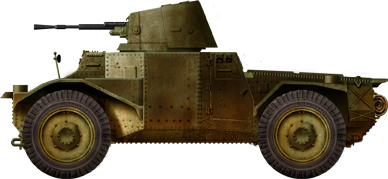
Vichy French Panhard AMD 35 ZT-2 in Vietnam, 1941.
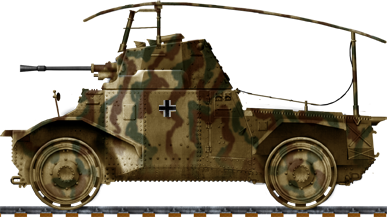
Schienenpanzer, Eastern Front, 1942.
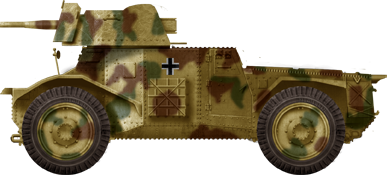
Panzerspähwagen P204(f) mit 5 cm KwK 38 L/42, Sicherungs-Aufklärungs-Abteilung 100, Southern France, 1943.
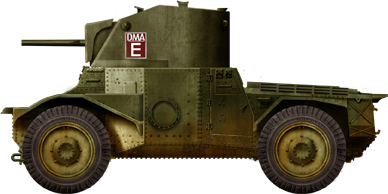
Panhard 178B/FL1, French Indo-China, 1947.
Sources : Trackstory n°2, www.minitracks.fr, GBM
White-Laffly AMD 50 in colonial service.
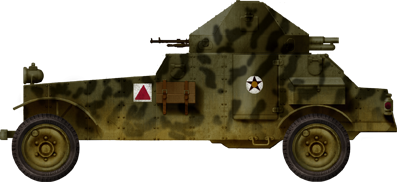
Laffly AMD 50 of an Algerian or Moroccan platoon.
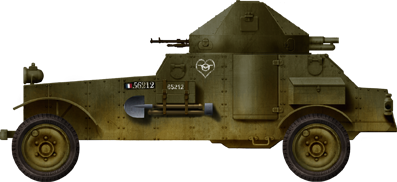
Laffly 50AM in France with the 4th GDI, May 1940.
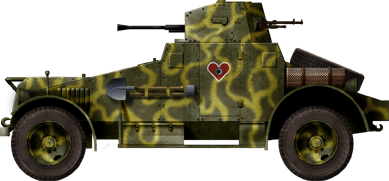
White-Laffly AMD 80.
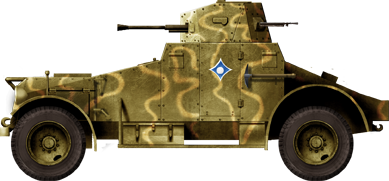
Laffly-Vincennes of the Chasseurs d'Afrique in Tunisia, 1943.
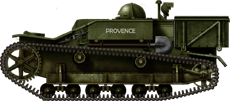
Regular UE tankette, early type, unknown infantry unit, "Provence". Normal paint was a dull bronze green.
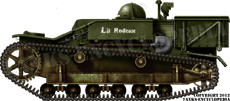
UE modèle 1931, early supply tankette, "La Rodeuse" (Grinder), unknown infantry unit, northern front, May 1940. Captured by German troops.
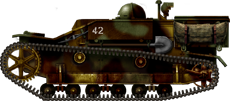
Renault UE2, late production (modèle 1937). This vehicle was painted with a three-tone camouflage (from a June 1940 photo), a rare occurrence, as supply tanks were uniformly factory-painted dull bronze green. Additional colors seem to have been added afterwards.
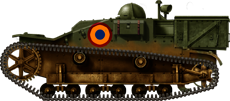
Şeniletă Malaxa tipul UE, a licence built Romanian supply tankette. 126 were built, of over 400 ordered, at the Malaxa factory in Bucharest. Production started in late 1939 and stopped in March 1941, when AMX stopped sending supply parts. They were based on the UE2 design and fought with the Axis in antitank companies.
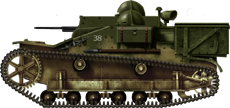
Renault UE1, armed prototype for the Chinese order (March 1936). A small boxy superstructure held a small ballmount machine gun model 1936 MAC 7.7 mm (0.3 in). A previous prototype, built in the fall of 1932, was rejected by the cavalry. Ultimately, the Chinese order motivated emergency production of derived models, as well as 200 modified tankettes with a small fixation for an external Hotchkiss machine gun. It is unknown how many of the MAC-Reibel type were delivered prior to June 1940.
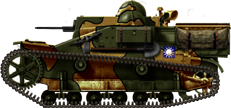
Ten armed UE (with a 7.7 mm/0.3 in MAC) were built and all were confiscated while en route for delivery by the Vichy French Indochinese authorities, under Japanese pressure. Apparently delivered in the fall of 1940.

Gepanzerte-MG-Träger Renault UE(f), early version, Yugoslavia, April 1941.
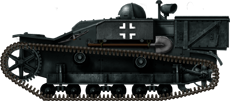
UE-Schlepper 630(f), Greece, April 1941. This configuration was the mainstay of all versions used by the Wehrmacht, in the very same duty. In practice, they towed the standard-issue PaK 36, but also the 50 mm (1.97 in) PaK 38, 75 mm (2.95 in) PaK 39/40/41 and 76.2 mm (3 in) PaK 36(r) anti-tank guns.

UE-Schlepper 630(f), towing a standard-issue PaK 36 infantry gun, mostly used by antitank detachments (Panzerjägerabt). Ammunition was housed by the large storage case behind the crew compartment.
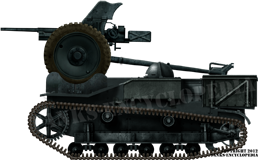
Selbstfahrlafette für 3.7 cm Pak36 auf Renault UE(f), early conversion, with the gun just held in place by a dedicated framework. 700 vehicles built. Most were sent on the Russian front, few survived until 1944. Their thin armor was an issue.
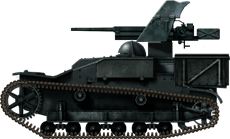
Selbstfahrlafette für 3.7 cm Pak 36 auf Renault UE(f), second and final conversion. Most of the Panzerjäger companies raised in May-June 1941 were equipped with these UEs converted as tank-hunter SPGs, equipped with a fixed standard PaK 36. This prolific gun, the infamous "door-knocker", was still efficient against most of the Russian tanks, like the BT series or T-26.
125th Panzerjägerabt, attached to the 125th Infantry Division, Russia, March 1942.
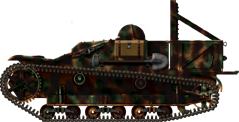
Mannschaftstransportwagen Renault UE(f), an infantry transport conversion. The bin was converted as a two men bench, while two other could sit on the large front mudguards and glacis. Unknown unit, Crimea, August 1942.

Gepanzerte MG Träger Renault UE(f) of a Luftwaffe Unit, converted version with a MG 34 machine gun and bigger gunner compartment.
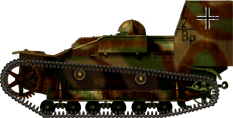
Kleiner Funk-und Beobachtungspanzer auf Infanterie-Schlepper UE(f), one of the fifty modified by the Beck-Baukommando as command vehicles, later affected to the (new) 21st Panzer Division. France, Normandy, June 1944. None of these UEs were ever registered in African units.

Italian Renault UE, Sicily, July 1943. The Germans sent about 64 UEs Chenillettes at the end of 1943. Most were kept in Italy and many based in Sicily as infantry ammunition suppliers when Operation Husky began in July 1943. Some were captured and served with US infantry for some time during the campaign. There is no known photo of a US captured Renault UE tankette or in Italian service. This illustration is purely the illustrator's recreation.
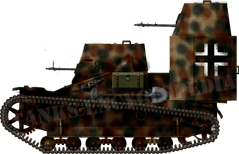
Sicherungsfahrzeug UE(f) from the regular security patrols of Luftwaffe airfields in recently taken or hostile territories, or bases against resistance and partisan raids. Others UEs were used as aircraft and bomb tractors.
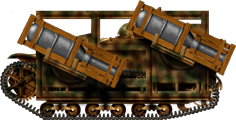
Selbstfahrlafette für 28/32 cm Wurfrahmen auf Infanterie-Schlepper UE(f) (heavy rocket launcher), early version, with frames on the sides, welded to the main body. They supported wooden launchers for the heavy 280 mm (11 in) rocket for infantry support. Russia, Kursk, August 1943.
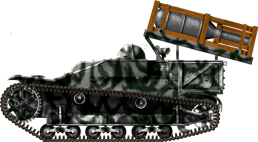
Late Selbstfahrlafette für 28/32 cm Wurfrahmen auf Infanterie-Schlepper UE(f). Around fifty conversions as rockets launchers were performed over the UE basis, including an unknown quantity of late conversions with a four stack ramp mounted over the bin. Belgium, December 1944.
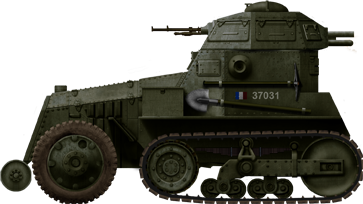
Citröen Kegresse P16 modele 28, shortly after delivery in 1929. Most had the peacetime uniform factory olive green livery.
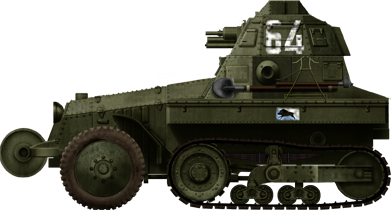
Schneider Kegresse P16 m29, 18th Dragoons, 1st DLM, France, 1936.
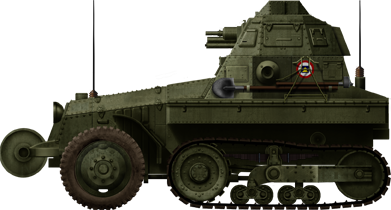
Schneider Kegresse P16 m29 radio command version, 3rd GRDI, France, 1939.
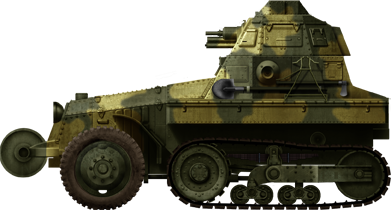
Schneider Kegresse P16 modele 29 of the 1st GRDI, Northern France, May 1940.

FCM 36 from the 4th BCL, January 1939.
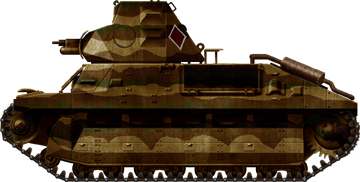
FCM 36 from the 503rd RCC, Meuse River sector, May 1940.
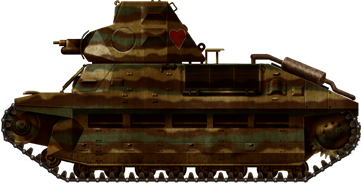
FCM 36 with a blended pattern, June 1940, Aisne Sector.
.png)
Pak 40 auf Panzerkampfwagen 737 FCM (f), XXIst Panzerdivision, Normandy, June 1944.
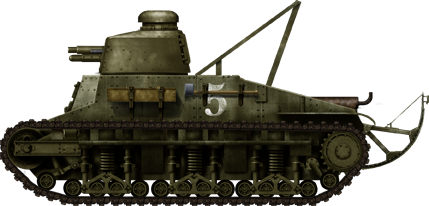
Renault NC28/NC2 in 1930, with the FT turret, test prototype without side skirts, showing the complicated suspension.
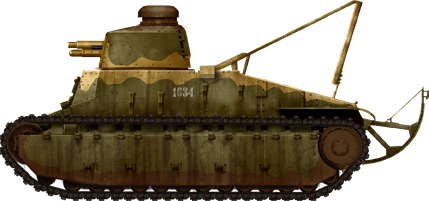
D1 pre-series in 1934, still using the provisional FT turret. These machines were later kept for training.
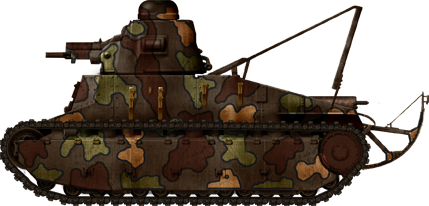
Tank #1032 during the tests of the Bernard tank transporter. Probably a unique early camouflage for trials in 1936. This particular livery was unveiled by P.Danjou for Minitracks.
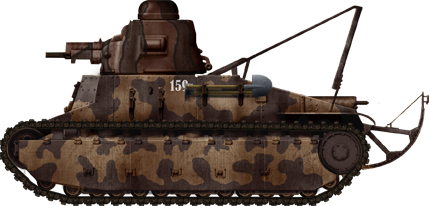
A D1 during maneuvers at Camp de Sissonne in June 1936. This pattern is featured in the last photo on this column.
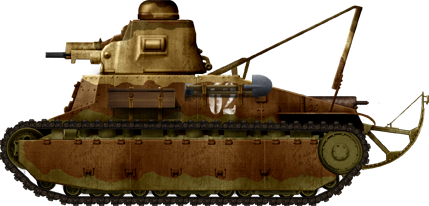
Char D1 with the regular "horizontal" pattern of 1937-38, Oran, Tunisia, 37 BCC, September 1939.
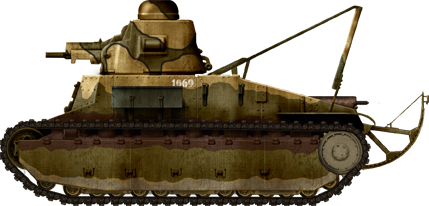
Renault D1 during the battle of France, 67 BCC, Souain sector, June 1940.
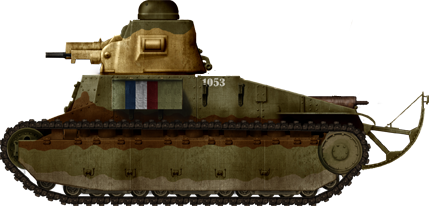
D1 of the French Free Forces in Tunisia, late 1942. These vehicles were striped of their antennae, and fought against Axis forces in eastern Tunisia, notably at the battle of Kasserine Pass.
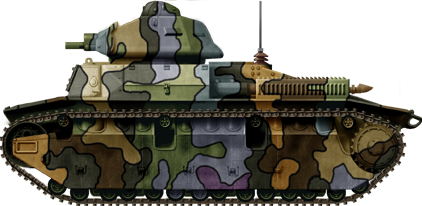
Renault D2, early production (model 1935), testing a complex 8 tone pattern in 1937. This particular camouflage by unveiled by P.Danjou for Minitracks.
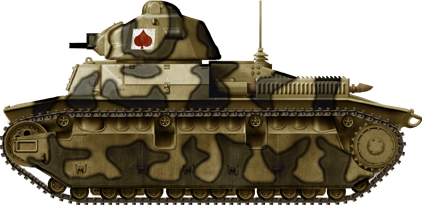
Renault D2, model 1935 (APX-1 turret), 3rd Company of the 19th BCC, May 1940.
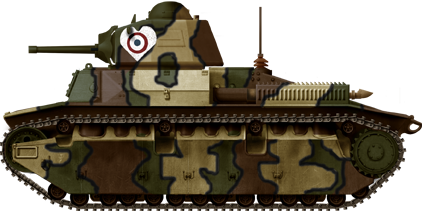
D2 model 1938, with the APX-4 turret and long-barreled 47 mm (1.85 in), which improved its offensive capabilities, 19 BCC, May 1940.Sources and more : Trackstory n°9, www.minitracks.fr, GBM.
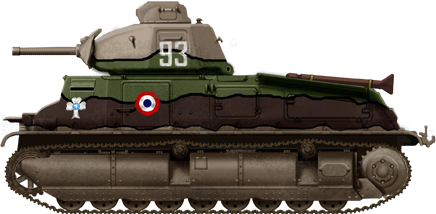
Second Cavalry Battalion, Gen. Billotte's First Army, Battle of Hannut, 13-15 May 1940.
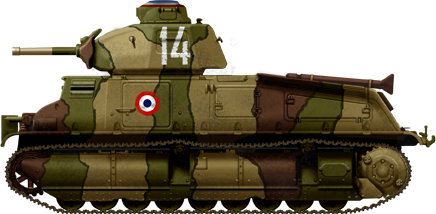
A regular S35 during the 1937 maneuvers, with the 4th Cuirassiers, the first cavalry unit to receive SOMUAs.
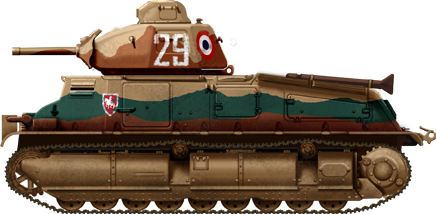 SOMUA of the 4th DCR (part of the 3rd Cuirassiers), during the Montcornet counterattack on 17 May 1940. It also fought at Crecy sur Seine and Laon.
SOMUA of the 4th DCR (part of the 3rd Cuirassiers), during the Montcornet counterattack on 17 May 1940. It also fought at Crecy sur Seine and Laon.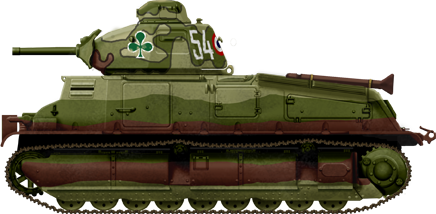
SOMUA of the 2nd DLM, which fought at Craonne, 14th May 1940.
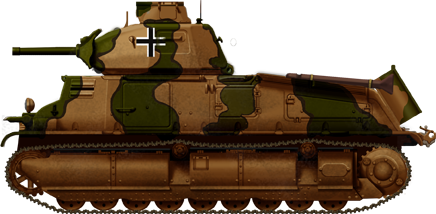
Panzerkampfwagen 35-S 739(f), 202nd Panzer Abteilung, Balkans, March 1944.

WW2 Tanks




























WW2 tanks posters

All Tiger tanks liveries.

Panther liveries and variants

WW2 Armour - All tanks











Tanks aces and single tanks series

Find more there

Museums, Movies, Books & Games
The Tanks and Armor in pop culture
Tanks and armored vehicles in general are only really grasped when seen first person: The mass, the scale, it's all there. Explore also the way tanks were covered in the movie industry, in books and in video games.Movies:
Best tanks movie on warhistoryonline.com
On imdb.com
On bestsimilar.com/
miltours.com
liveabout.com/
watchmojo.com
Video Games:
pcgamesn.com
historyhit.com
levvvel.com
vg247.com/best-tank-games
mmobomb.com/
alienwarearena.com

